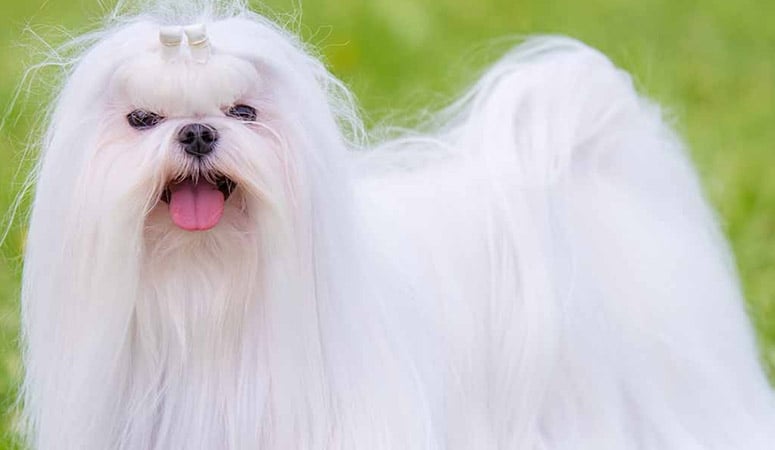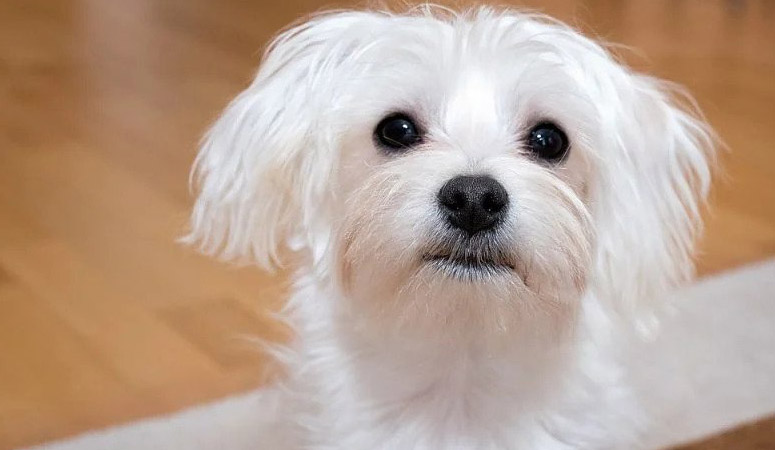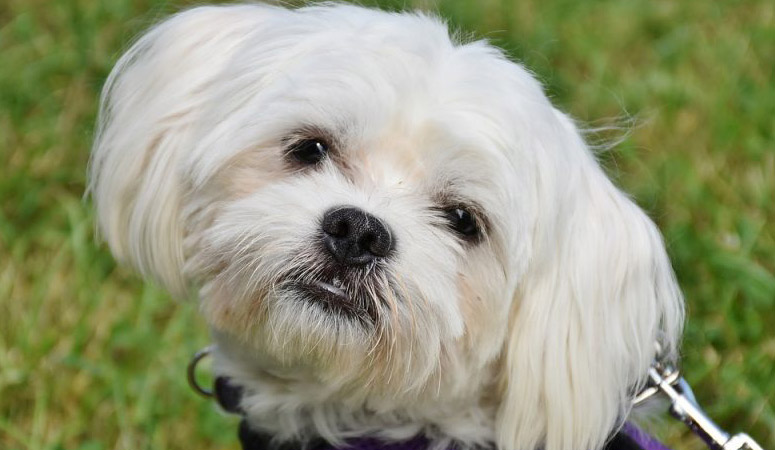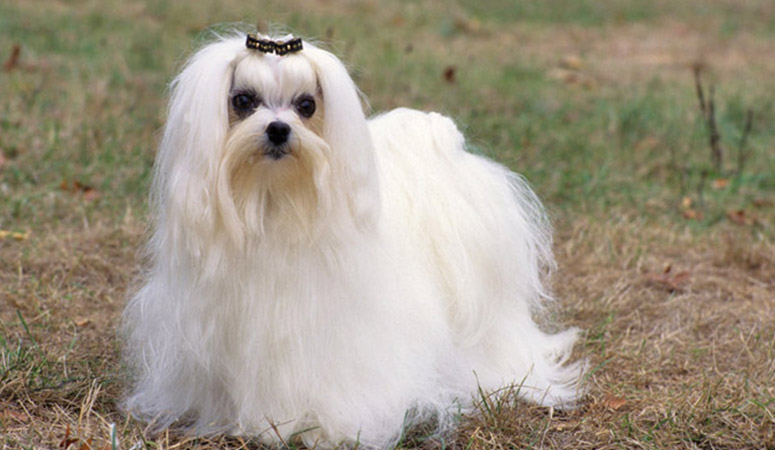Maltese
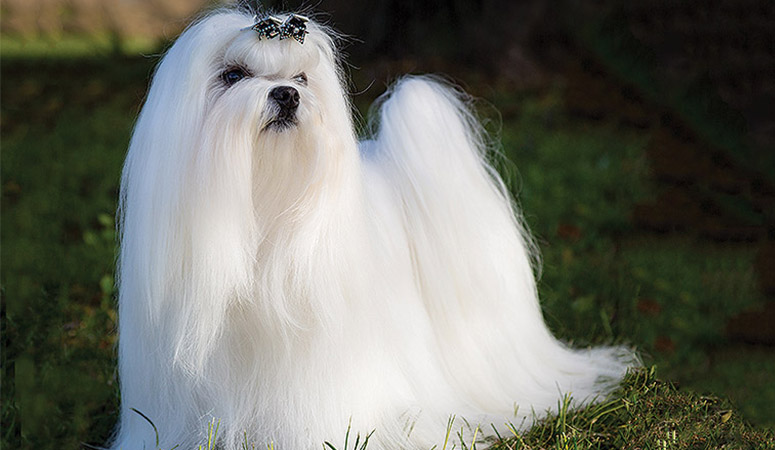
With floor-length, all-white coat and lively personality, the Maltese is affectionate, charming toy dogs and companions. They are bred with smooth gait, which help them maintain balance and elegance. Easy to get along with people, the dog can live a long life with few requirements of exercise and shedding.
| Other Names | Bichon Maltais, Bichon Maltese |
| Color | White |
| Height | Males: 8-10 inches. Females: 7-9 inches. |
| Weight | Males: 6-9 pounds. Females: 6-9 pounds. |
| Life Span | 12-15 years |
| Personality | Gentle, Playful, Charming |
| Exercise | Regular Exercise |
| Origin |
| Popularity | #36 |
| Groom Needs | Daily Brushing |
| Kids Friendly | Yes with supervision |
| Dog Friendly | Yes with supervision |
| Watch Dog | |
| Family Dog | |
| Litter Size | 1-3 |
Maltese Pictures
Maltese Video
Introduction
This is an elegant little dog, the Maltese, part of the toy dog breeds and famed for his soft silky white hair. The Maltese does not have an undercoat of hair so he does not shed a lot of hair. They are what people might say the sweetest little dogs, alert, intelligent, and when you get one, you will find he is a devoted companion. They need plenty of attention; you can’t buy one and just go off to work and leave this little pet; he needs plenty of attention and can even suffer from separation anxiety if left alone for hours on end. Then he can bark a lot and become destructive through no fault of his own. Because they are small and delicate, they are not really recommended for houses that have small children. Avoid buying so-called tea cup Maltese pups – a dog that weighs less than 4 pounds at maturity. They usually end up with genetic problems and will have a higher health risk. Maltese should be around 8-10 inches at the shoulder. Regular walks, nutritious food, and enough playing and exercises will have you blessed with what can only be said, a wonderful companion.
Living with Maltese
With long, white coat, the Maltese looks glorious and charming, but the coat is easy to get dirty. So the coat needs daily brushing and bath weekly to keep from tangles and mats with the help of conditioner and detangler. But they don’t need to shed much. Using shampoos every few weeks can help keep the coat silky and clean. Cut the dog’s hair and make it shorter, which can make the grooming easier.
Wash the beard on the dog’s chin and the fur below your dog’s eyes after every meal to keep from tear and food stains.
Brush the teeth two or three times a week to help remove the bacteria and tartar, keep good breath and prevent gum disease.
Clean his ears at least once a week. If there is a bad odor, you should take him to the vet. Have Maltese’s nails trimmed every few weeks to prevent wax buildup and infection.
Maltese doesn’t need plenty of exercises, although they are active, which make them good pets for the elderly and apartments. But proper exercise can help your dog keep body health.
Maltese love playinggames and tricks in the yard. As house dogs, they never like to be left alone for any length of time. Short walks or short play time whether outdoors or indoors to keep fit and healthy are needed every day.
With short legs, the Maltese can trot by your side but it can’t last too long. But the breed is willing to hike with the owner for one to two miles. Most Maltese can’t tolerate cold weather well although they have long coat. So if you take the dog with you outside, give him a coat and make sure the dog feels warm.
High-quality dry food is required for Maltese to keep body health. A half cup to one cup twice a day is appropriate, but the exact type and amount of food should vary with the dog’s activity level, size, metabolism and age. The Maltese usually tend to stay in good weight, and a balanced diet should be promised for an adult dog.
Measure the food instead of leaving food out all the time when feed the dog and control the calories strictly to keep him from getting overweight.
With a history of digestive issues, the breeder should know what and how to feed the dog. Vegetables, quality proteins and fruits are good for Maltese. Clean, fresh water should be available at all times.
The gum and teeth problems may lead to eating problems. So take him to the vet for a checkup if there are any concerns about the dog’s diet and weight.
With few health issues the Maltese is a healthy breed. But just like other dog breeds, they’re prone to certain health conditions, such as patellar luxation, portosystemic shunt, progressive retinal atrophy, collapsed trachea, deafness, hypoglycemia, periodontal disease, white dog shaker syndrome, glaucoma, etc. Responsible breeders will screen their stock for health conditions regularly.
The bile-acid test can help Maltese puppies to recognize congenital liver issues, such as microvascular dysplasia (MVD).
Have the breed’s teeth brushed with special toothpaste every day can help him maintain good dental condition. Also regular cleaning is important for the dog to keep fit.
Take your dog with Cardiac Exam and Patella Evaluation and check with your vet regularly can help prevent some diseases. The breeders should learn about some symptoms of health conditions and know how to deal with when these problems occur.
Total Annual Cost: $2889
Cost is estimated for the first year and may vary depending on many factors, such as dog food, health care, leash, collar, licensing, possible fencing, crates, training and obedience classes, dog-walking, grooming, treats, toys, flea, tick, and heart-worm meds, microchips, etc.
The Maltese is easy to train with intelligence but a little difficult to housebreak. Early training of socialization and exposure to different people, pets and places are required, which can prevent the dog from being shy or aggressive when face strangers.
Crating training or keep the breed under your supervision is a good way to housetrain. You can keep them on leash in your house, or you should keep it in the crate if you can’t watch them.
Take a walk with your dog in the morning or before they go to the bed. And take your dog outside also can help a lot after eating and playing. Give proper praise or other rewards when the dog finishes its business.
Watch out the dog’s barking because the breed has a habit of barking excessively and it’s difficult to break. The training needs a lot of time, patience and love, so you should prepare for this well if you want to breed a Maltese.
History
They take their name from the island of Malta. The exact origin is not known, some believe from the Isles of Malta in the Mediterranean and others say from Italy, whilst others say from Asia.
Throughout his long history, the Maltese have been given many names, such as “Melitae Dog,” “Ye Ancient Dogge of Malta,” the “Roman Ladies Dog,” “The Comforter,” the “Spaniel Gentle,” the “Bichon,” the “Maltese Lion Dog,” and the “Maltese Terrier.” But today, everyone just calls him the Maltese.
His history can be traced back to at least a couple of millennia.
Many people have immortalized this little dog in the early years of Greek, Roman, and Egyptian history.
Even Aristotle mentioned them around 370BC, dogs called “melitaei catelli,” – likely to be the Maltese.
It was the Egyptians and Europeans later on who thought that the Maltese even had the ability to cure people of diseases – they would be placed on the pillows of ill people – hence the name, “The Comforter.”
By the 15th century, the Maltese were popular amongst the French aristocrats but nearly destroyed in the 17th and 18th centuries when people were trying to breed with them. Finally, English breeders developed the dog to what we know today.
They were first seen in the US in the late 1800s.
They are registered with the American Kennel Club at around 37th in popularity.
Helpful Information
Breed Club: AMERICAN MALTESE ASSOCIATION
Breed Club Link: https://www.americanmaltese.org/
Breed Club Rescue: American Maltese Association Rescue
Breed Club Rescue Link: https://www.americanmalteserescue.org/

